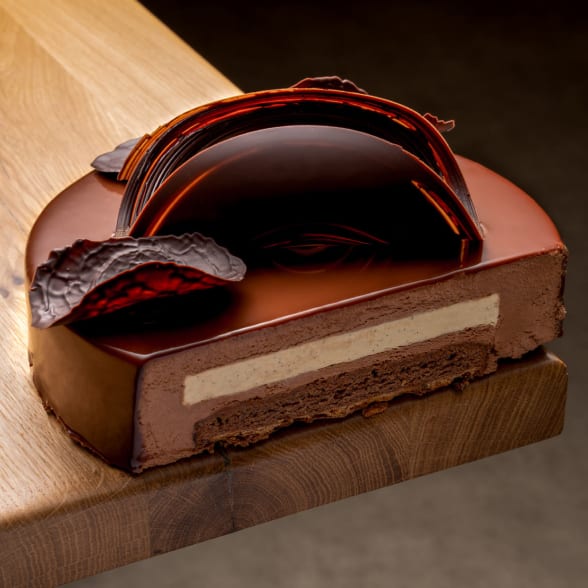Contents :
What is ganache?
In pastry-making, a ganache is usually made using crème fraîche and chocolate. It is an essential part of many recipes, both in pastry- and chocolate-making.
A little folk tale explains where this delicious blend of cream and chocolate comes from.
According to legend, we owe ganache to a mid-19th century apprentice. He clumsily spilled boiling cream over chocolate and, so he wouldn’t get caught, he mixed them together, creating the delicious product we know today. His mistake earned him the name ganache (or “imbecile”) from his master, who named the creation after his hapless apprentice.
Making a chocolate ganache: the Valrhona method
There are many very distinct types of ganaches. There are whipped, alcohol-infused, poured or classic ganaches, as well as variations defined by flavors and recipes, such as vanilla, raspberry, spiced and so on.
Making a classic ganache
Classic ganaches are an essential preparation for everyone from pastry-making beginners to master chocolatiers.
They help you make all kinds of desserts and confectionery, as you will see below.
Chocolate ganache isn’t very difficult so long as you follow each step and know how to emulsify your ingredients. For perfect results, consider using quality chocolate, for example chocolatier’s drops.
For this recipe, you will need 400g of liquid cream, 100g of sugar (invert sugar, glucose or other), 450g of dark chocolate (Guanaja or similar) and 50g of butter (optional).
- Bring the cream to a boil with the sugar. At the same time, partially melt the chocolate.
- When the cream is hot, add a quarter of the cream to the drops and mix to bind the ingredients together.
Note: Check the temperature so you know your preparation is over 95°F (35°C) and the cocoa butter has melted. If it hasn’t, heat the cream and chocolate mixture. - Repeat this process by adding the second and then the third quarter of cream. For the last quarter, you can use an electric mixer to perfect the emulsion.
- Before incorporating the butter, take the mixture’s temperature again. It must be between 95 and 105°F (35 and 40°C).
Cut up the butter, stir it into the mixture and blend.
Note: Butter isn’t essential but it gives your ganache a more melt-in-the mouth texture. - Your ganache is now ready to use. You might have to let your ganache crystallize depending on what you want to do with it.
Making whipped ganache
For a whipped ganache, you will need to make a classic ganache but without the butter. Once you have an emulsion, add your cream and chocolate mixture’s weight in liquid cream.
Note that the cream must be 35% fat and cold so that the ganache is easier to make.
By leaving the mixture in the refrigerator for a few hours, you will ensure it whips up better.
To mix the ganache, use a whisk or the slow setting in blender to incorporate as much air as possible.
Be careful not to mix too quickly or for too long, as the ganache can break up and become grainy. To avoid this, make sure your preparation is quite cold and whisk it slowly.
Quantities vary from one recipe to another and depend on the ingredients you use. Dark chocolate requires more cream because of its higher cocoa butter content.
How can you rescue an overly runny ganache?
Sometimes a ganache might be too runny for us to get the result we want. Before you do anything else, make sure you have given your preparation time to cool down. Let it rest in the refrigerator if not.
If your ganache is still too runny, it is because the chocolate and cream haven’t bonded well. To rescue it, you can always heat your ganache in a bain-marie and add in a little more chocolate.
What can you do with chocolate ganache?
Lots of products use ganache in its various forms. It can be used liquid as soon as you have made it, but can also be used solid.
It all depends on the type of confectionery or pastry you want to make, and the recipe you use.
Using a liquid ganache
In its liquid form, ganache can be used in many desserts and as a filling for tarts, including the famous chocolate tart. Finally, it can also be used as a chocolate sauce.
Using a solid ganache
Certain desserts or gateaux require a solid ganache base. This is the case for macarons, which are filled with solidified ganache. Like gianduja, the chocolate truffles you might enjoy during the festive season can also be made with a solid ganache. Finally, solid ganache can be used as a decoration for pastries and baked goods, for example as a topping for cupcakes.
Final thoughts on ganache
As we have seen, ganache is an essential pastry- and chocolate-making preparation used in many recipes. Learning how to make chocolate ganache is a vital skill
Remember you aren’t limited to the handful of examples of ganache-based creations we have seen: With a dash of creativity and a good ganache, you can design original tarts, desserts and gateaux that look and taste delicious.
